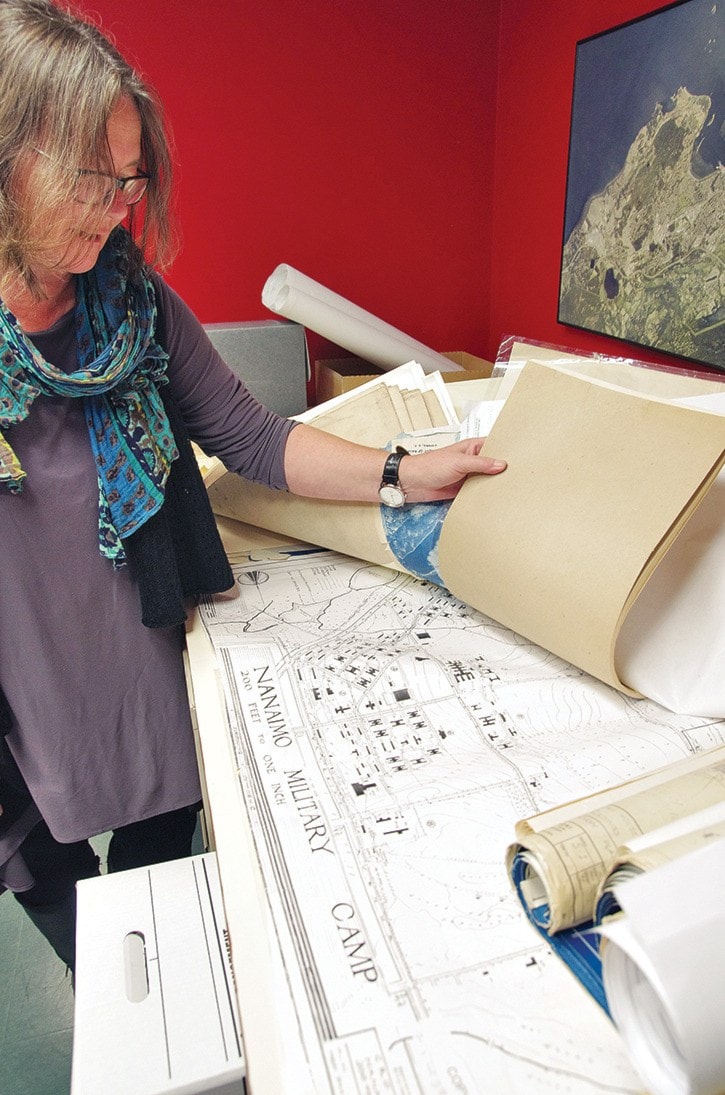A patch of ground in Harewood played a significant role in Canada’s involvement in the world’s conflicts.
When the Second World War broke out in Europe in 1939, farmland west of Wakesiah Avenue traded plowshares for swords when it became Nanaimo Military Camp, a small-arms training base for Canadian troops.
Now under subdivisions, community recreation facilities and learning centres, the former base left a Nanaimo enduring long past its brief wartime heyday.
“So this has to be early days because they’re still all in tents,” said Christine Meutzner, Nanaimo Community Archives manager, as she views old home movies of the camp on a computer screen. “The one where it shows the actual grounds is really good. All of a sudden there’s a guy in the middle of a field playing an accordion. It’s kind of weird.”
The films give a glimpse of camp life, but a scrapbook in the archives, compiled by Connie Filmer, who was in her 20s at the time, details the social impact the 16,000 men with 36 regiments who trained there made on the community.
“It was a very brief span [of time], but during that span – this is what I’ve always been told – that was one of the most exciting times in Nanaimo’s history,” Meutzner said. “This huge influx of single men. There was an awful lot of babies born during that period, too. That’s when [former Nanaimo jazz club] the Pygmy Pavilion was, like, crazy. They’d have all these bands coming in and it was very vibrant. There was this huge, common cause sort of feeling and people were very patriotic about it.”
Filmer’s scrapbook contains names and signatures of camp commandants, invitations to social events listing dinner menus and entertainment, regimental business cards and uniform shoulder patches, newspaper clippings about camp events and the war.
In 1946, much of the land was sold and a portion was turned over to the Department of Indian Affairs. The remaining acreage between Fifth Street and Nanaimo Lakes Road found its place among the Canadian Armed Forces’ role in the Cold War as a communications centre and home to one of Canada’s string of nuclear fallout shelters, nicknamed Diefnebunkers, commissioned by late prime minister John Diefenbaker in 1959 during tensions between the U.S. and former Soviet Union.
The bunkers were shelters for heads of state if nuclear war broke out.
The Nanaimo site was chosen because meteorological records showed prevailing winds would blow fallout from missile strikes in Vancouver or Victoria away from the Island, said Roger Bird, Vancouver Military Museum president and former captain with the Royal Canadian Army.
Bird was one of the men responsible for decommissioning Nanaimo’s Diefenbunker and the camp from the regular forces in 1995.
“They called them the Diefenbunkers because during the Conservative years, they put them in provinces that the Conservatives held,” Bird said.
Most bunkers were destroyed, but Nanaimo’s was stripped of its equipment, sealed and buried in 1999.
Today the camp is home to army reserve units, including the 5th Field Artillery Regiment, the Canadian Scottish Regiment ‘B’ Company, the 748 Communication Squadron and also used by military cadet units.
Archival films of the camp can be viewed online at http://bit.ly/2fk1NO1.
